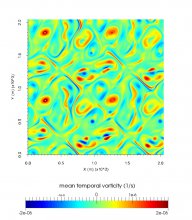The air-sea interaction at the (atmospheric) synoptic and the meso-scale due to momentum transfer, only, is con-
sidered. Two superposed one-layer fine-resolution shallow-water models are numerically integrated. The upper
layer represents the atmosphere and the lower layer the ocean. The frictional force between the two-layers is im-
plemented using the quadratic drag law. Experiments with different values of the surface friction drag coefficient
are performed. The actual energy loss of the atmosphere and the energy gain by the ocean, due to the interfacial
shear, is determined and compared to the estimates based on average speeds. The correlation between the vorticity
in the atmosphere and the ocean is determined. Results differ from previous investigations where the exchange of
momentum was considered at basin scale. It is shown that the ocean has a passive role, absorbing kinetic energy at
nearly all times and locations. Due to the feeble velocities in the ocean, the energy transfer depends only weakly
on the ocean velocity. The ocean dynamics leaves nevertheless its imprint in the atmospheric dynamics leading
to a quenched disordered state of the atmosphere-ocean system, for the highest value of the friction coefficient
considered. This finding questions the ergodic hypothesis, which is at the basis of a large number of experimental,
observational and numerical results in ocean, atmosphere and climate dynamic.
Accueil > Équipes > Équipe MEIGE > Diffusion scientifique > Séminaires internes
Interaction and energy transfer between an atmospheric and an oceanic layer at the synoptic and the meso-scale
21/05/2015 Aimie Moulin





